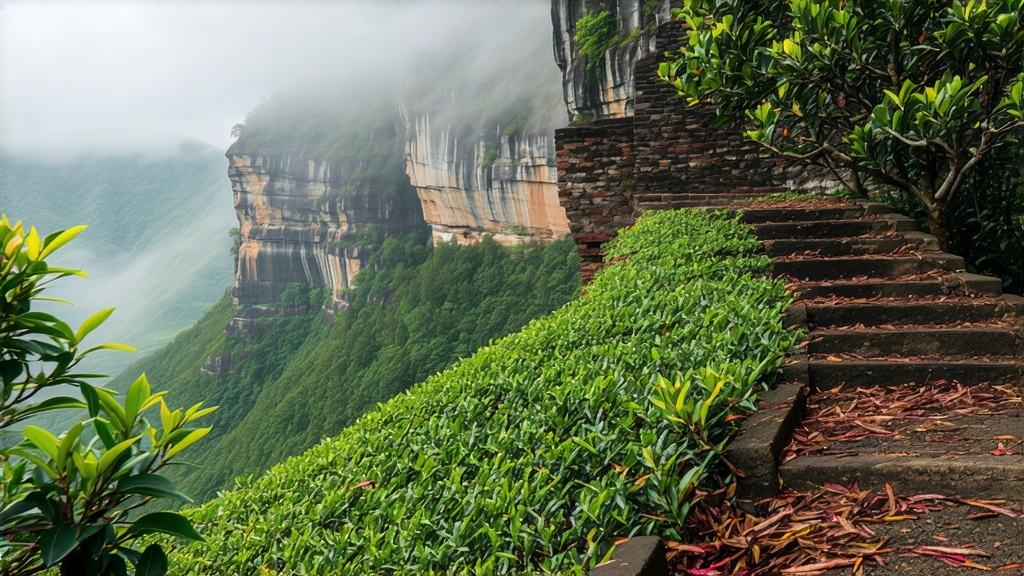
When Chinese tea lovers speak of “rock bone and floral fragrance,” they are invoking the spirit of Da Hong Pao, the most celebrated of all Wuyi yancha (rock oolong) teas. Grown on the precipitous cliffs of northern Fujian’s Wuyi Mountains, Da Hong Pao is not merely a beverage; it is a 350-year-old legend pressed into twisted, charcoal-kissed leaves. International drinkers often meet it first through ornate gift tins or museum-like tea shops, yet the true story is far wilder: a tiny cluster of mother trees, impossibly rooted in almost vertical crevices, once produced leaves so treasured that they were used to cure an emperor’s mother and subsequently guarded by soldiers. Today the originals—six venerable bushes on Tianxin Rock—are retired from plucking, but their offspring, propagated through cuttings, carry the same mineral DNA and continue to astonish palates from Berlin to Melbourne.
To understand Da Hong Pao one must begin with terroir. The Wuyi range is a UNESCO World Heritage site where granite cliffs plunge into the Nine-Bend River, creating a humid microclimate that alternates between fog and short, intense bursts of sun. The soil is so thin that roots must fracture rock to find nutrients, absorbing calcium, potassium and magnesium that later translate into the tea’s signature “yan yun” (rock rhyme)—a lingering, almost musical note that vibrates at the back of the throat after swallowing. Locals describe this sensation as “mountain within water,” a poetic way of saying that the tea tastes of both stone and stream.
Although the name Da Hong Pao literally means “Big Red Robe,” the tea family is more nuanced than a single cultivar. Three broad categories exist: mother-tree, purebred and blended. Mother-tree tea is now illegal to harvest; the last authorized picking was in 2006, and the 20 grams produced were presented to the National Museum of China. Purebred Da Hong Pao, also called Qidan, comes from asexually propagated cuttings of the original bushes, preserving their genetic identity. Blended versions—commercially the most common—marry leaves from several Wuyi cultivars such as Rou Gui, Shui Xian and Tie Luo Han to approximate the mother tree’s profile. Skillful blenders can create harmonious teas that cost a fraction of purebred lots, yet still deliver cocoa, orchid and wet stone aromatics.
Processing Da Hong Pao is a month-long choreography of stress and rest. Picking occurs in late April when leaves have reached the “medium small” standard: three to four centimeters, thick enough to withstand repeated bruising. Pluckers take only the central three leaves, believing that the second leaf possesses the ideal ratio of polyphenols to amino acids. The first step is sun-withering, where leaves are spread on bamboo mats for 20–30 minutes, depending on cloud cover. UV light triggers grassy aldehydes to break down, laying the groundwork for later fruity notes. Once the leaf edges feel velvety, the tea is moved indoors for “cooling green,” a quiet rest that equalizes moisture.
Next comes yaoqing, the rocking-green phase that defines oolong. Leaves are tumble-tossed in a bamboo drum rotating at 18 rpm, bruising the edges just enough to rupture cells and initiate oxidation while keeping the center green. Master tea makers listen for a subtle “pop” that signals the release of aromatic enzymes. This step is repeated six to eight times across the night, each cycle followed by 45-minute pauses during which leaves breathe on woven racks. By dawn the leaf margins have turned russet, a color that reminded Qing-era scholars of Buddhist monks’ robes—hence the name Red Robe.
Oxidation is arrested by a 220 °C tumble in an electric wok, a modern adaptation of the charcoal woks once heated with local pine. Charcoal firing, however, is far from obsolete; it is resurrected during the final roasting stage that gives Da Hong Pao its campfire depth. Roasters stack bamboo baskets above a pit of glowing embers made from Cyclobalanopsis wood, whose slow, even heat penetrates the leaf for eight to twelve hours. The tea is allowed to cool for three days, then re-roasted; premium grades may endure three such cycles. Between each roast the leaves “return to soul,” absorbing ambient humidity that softens harsh edges. The result is a strip-shaped leaf, glossy obsidian with chestnut flecks, releasing aromas of